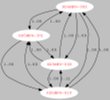This is the closest geographical forum I could find to our area. If I posted in a wrong place, oops.
This is a copy of a post I did on another reflector concerning San Diego area and its combined Ubiquiti Private LAN and BBHN Mesh linking. Nothing unique I imagine, just information to show its utility and efforts being done on cross border communications.
The following is a synopsis of the USA-Mexico efforts concerning Broadband mesh nodes and connectivity with the HDRENS/CREBC Lan:
W3NRG-100 is a Ubiquiti flashed M2 mini-grid 11x14 mounted on a tripod. This is on the roof of one of the tall Condo complex buildings in Coronado. It is directed horizontally towards Tijuana for connection to XE2BNC-100. The distance is 14.2 miles. The node is RJ-45 connected to the HDRENS LAN at this point.
XE2BNC-100 is the other side of this mesh node link and is a TP link company 24 dBi grid driven by a flashed Ubiquiti bullet. The site is near the Tijuana TV towers closest to the San Ysidro border crossing, and visible from the US.
XE2BNC-101 is a Linksys mesh node inside the radio vault using its attached rubber antennas. It is RJ-45 connected to the CREBC/HDRENS LAN switch at this point. It's purpose is to allow an interface for mesh gateway control. It talks to XE2BNC-100 and -102 via mesh WiFi.
XE2BNC-102 is a Ubiquiti flashed M2 HP large grid with vertical polarity and directed to the CREBC Hub site located on a ridge further into T.J. proper. This distance is 3 miles.
XE2BNC-103 is a 15 dBi 4 foot tall omni antenna with a flashed bullet mounted at the base. The concept here is since this site sees several club members and the club station itself, that an omni might distribute mesh over a 2-3 mile area.
Later this week XE2BNC-104 will be installed at my home and it will be a Ubiquiti vertical polarity M2 mini grid pointed to XE2BNC-103. Distance is at 1.3 miles. This will then give complete access via mesh WiFi to all connected mesh nodes.
Total number of hops when completed: 5
Total mesh system distance at this point: 18.5 Miles/29.77 Km
At this juncture in the project, we can allow mesh nodes access to our LAN resources but to do this we have to turn mesh gateway on at XE2BNC-101. The disparity in sub-nets and IP ranges do not allow full two way connectivity between the two LAN's. Conrad and Andre may have a solution in the future. Conrad and Andre have been supportive of the project and it is appreciated.
It is planned by Andre to try to connect to our side via one of their established sites in the future.
Preliminary testing did show a path existence towards Qualcomm site and beyond.
The HDRENS/CREBC high speed private LAN covers over 40 miles and over 30 node sites with about 75 devices connected. It is based on Ubiquiti 2.4 and 5 Ghz equipment and part 97. The mesh system is part 15 so consideration on what is crossed over and allowed will need controls.
Also bandwidth and user congestion is a consideration.
On the HDRENS/CREBC LAN site bandwidth of both internet and LAN speed are in place. Our LAN speed is an average of 100 Mps. The US side, HDRENS, is about to extend their side to Mt. Soledad and beyond. Thus extending the systems range into greater parts of the San Diego county proper.
It is not an provider of internet for general user use, nor is any sold. The internet is available for the security cameras, IRLP nodes, APRS, and WinLink products. But all HDRENS/CREBC LAN resources can operate with no internet, the basic purpose of this Emcomm network.
While this is a robust backbone, there is still a lot of traffic moving. Plus two points are reduced to around 30-52 Mps that cross into the US for HDRENS connectivity. These links are planned to be improved in the future.Security and mesh node users access will have to be addressed.
All the indicated mesh nodes are connected to the same battery backup system that the part 97 LAN uses at each radio site. All are installed in the same solid mounting and site consideration as the part 97 network.
The concept is to perhaps allows small mesh colonies to ride the "backbone" for regional connectivity. Thus allowing a wider footprint for Emcomm and amateur development and experimentation.
The Baja portion of the network, both part 97 and now part 15, are there for club member and radio site connectivity plus emergencies, as there is agency activity in place and planned for this side.
Thanks also to Ed W3NRG for his efforts and Juanito XE2BGF for climbing towers.
Hope this explains a bit of what is occurring and this may be the first cross border mesh node network in place.
---------------------------------------Update: 9/29/2014
Have had a Bullet crash and had to be factory restored. Also links appear to sometime just go away then come back. Waiting for next beta to 3.0.
Mike xe2/n6kzb
